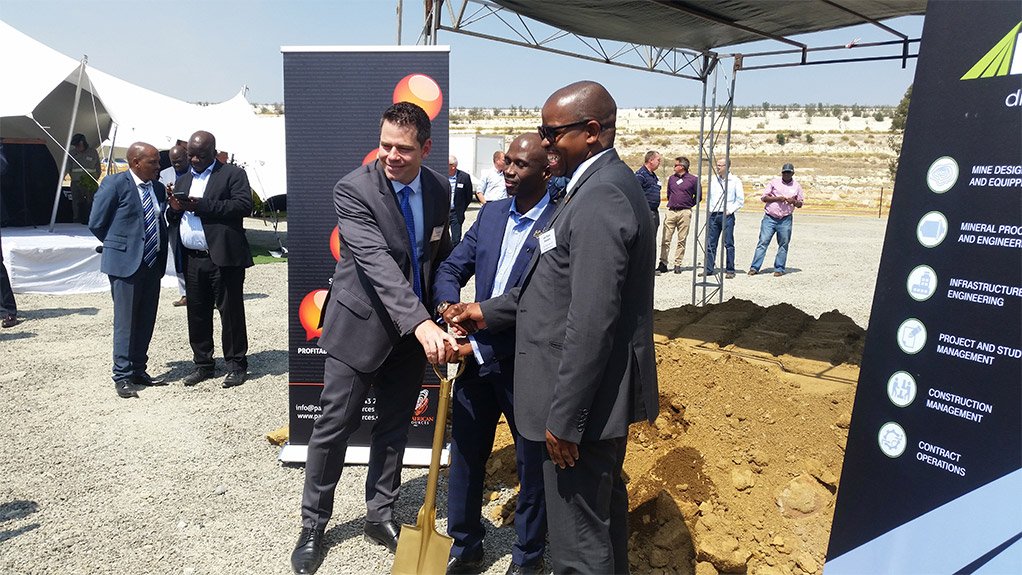EVANDER (miningweekly.com) – Government, trade unions and traditional leadership have heaped praise on South African precious metals miner Pan African Resources for the development of its R1.7-billion Elikhulu tailings retreatment plant (TRP) project, located at the company’s Evander gold mine, in Mpumalanga.
Speaking at the sod-turning ceremony on Friday, Department of Mineral Resources (DMR) director-general Advocate Thabo Mokoena said that the project came at a critical juncture, as his department had recently faced the serious challenge of mass retrenchments, owing to the restructuring and mothballing of operations – a result of the current depressed economic climate.
Mokoena said that Pan African’s fortitude to persevere with the project and bring it to realisation despite these challenges was “highly praiseworthy” and stood as an example to the rest of the industry of what could be achieved.
Mpumalanga Finance, Economic Development and Tourism MEC Eric Kholwane echoed the DMR’s sentiments, noting that mining was a critically important element of the Mpumalanga economy and that the province was committed to working with Pan African to ensure the success of the project.
The province would also focus on ensuring that the local community benefited “as much as possible” from the opportunities that would be created throughout the development of the project and during the project’s operating life.
He added that it was important for the company to assist, where possible, in ensuring that locals became employable and that Pan African should do so by partnering with the local government on skills development initiatives. This would ensure that local community members had the required knowledge and skills.
Mining Weekly Online spoke on the sidelines of the event with several traditional leaders and their representatives from the region, who all agreed that Elikhulu was a positive development for the area and one that they hoped would be replicated by other miners in the region. The traditional leaders believed the project would assist in addressing the challenge of unemployment in the region, particularly among the youth.
National Union of Mineworkers deputy president Joseph Montisetsi was also upbeat about the project, stating that the development of new projects was important for mineworkers’ morale, particularly in light of ongoing retrenchments that had occurred recently and/or were slated to take place in the coming months.
Speaking at the sodturning ceremony, Pan African CEO Cobus Loots highlighted that the project would create more than 700 jobs during the construction phase and about 250 direct permanent jobs once the plant was in production.
The project is expected to produce 689 000 oz of gold at an all-in sustaining cost (AISC) of about $550/oz over its 13-year life span. Construction of Elikhulu is scheduled to be completed by the third quarter of 2018, with the first gold pour targeted for the final quarter of 2018.
“Elikhulu’s capital expenditure of R1.7-billion is a substantial investment in the South African mining industry and is expected to contribute materially to the economic development and employment situation in Mpumalanga,” stated Loots.
He further highlighted that few gold producers could produce gold at an AISC of about $550/oz and that this would make Elikhulu one of the most cost competitive gold projects worldwide. Loots also pointed out that the project was expected to reduce the group’s AISC overall.
PROJECT OVERVIEW
The Elikhulu project entails the establishment of facilities and infrastructure to retreat historic gold plant tailings at Evander at a rate of one-million tons a month.
The definitive feasibility study (DFS) on the project was undertaken by multidisciplinary international engineering group DRA, which has been appointed as the primary engineering, processing and construction contractor on the project.
DRA will deliver a detailed design and construction supervision service for the Elikhulu gold tailings retreatment facility.
DRA’s scope of services through all stages of the project include the reclamation of the three existing storage facilities, namely Kinross, Leslie and Winkelhaak.
Additionally, DRA will be responsible for water supply to the project as a whole; water supply to each of the reclamation sites; hydraulic mining infrastructure; a new carbon-in-leach (CIL) gold recovery process plant; pump and piping systems to transfer the hydraulically mined tailings slurry to the new CIL process plant; residue disposal pumps and piping systems to deposit the tailings in a new tailing storage facility (TSF); and the construction of the new TSF.
DRA has subcontracted mining services company Fraser Alexander to undertake the construction of the TSF.
The three existing tailings storage TSFs, namely Kinross, Leslie and Winkelhaak, will, after being processed, be consolidated into a single enlarged Kinross facility, thereby reducing the mine’s environmental footprint and associated environmental impact.
According to key highlights from the DFS study, the project is expected to yield about 56 000 oz/y of gold for the initial eight years of production, while treating the Kinross and Leslie TSFs, and then about 45 000 oz/y for the project’s remaining six years from processing the Winkelhaak TSF.
Edited by: Samantha Herbst
Creamer Media Deputy Editor
EMAIL THIS ARTICLE SAVE THIS ARTICLE
ARTICLE ENQUIRY
To subscribe email subscriptions@creamermedia.co.za or click here
To advertise email advertising@creamermedia.co.za or click here













